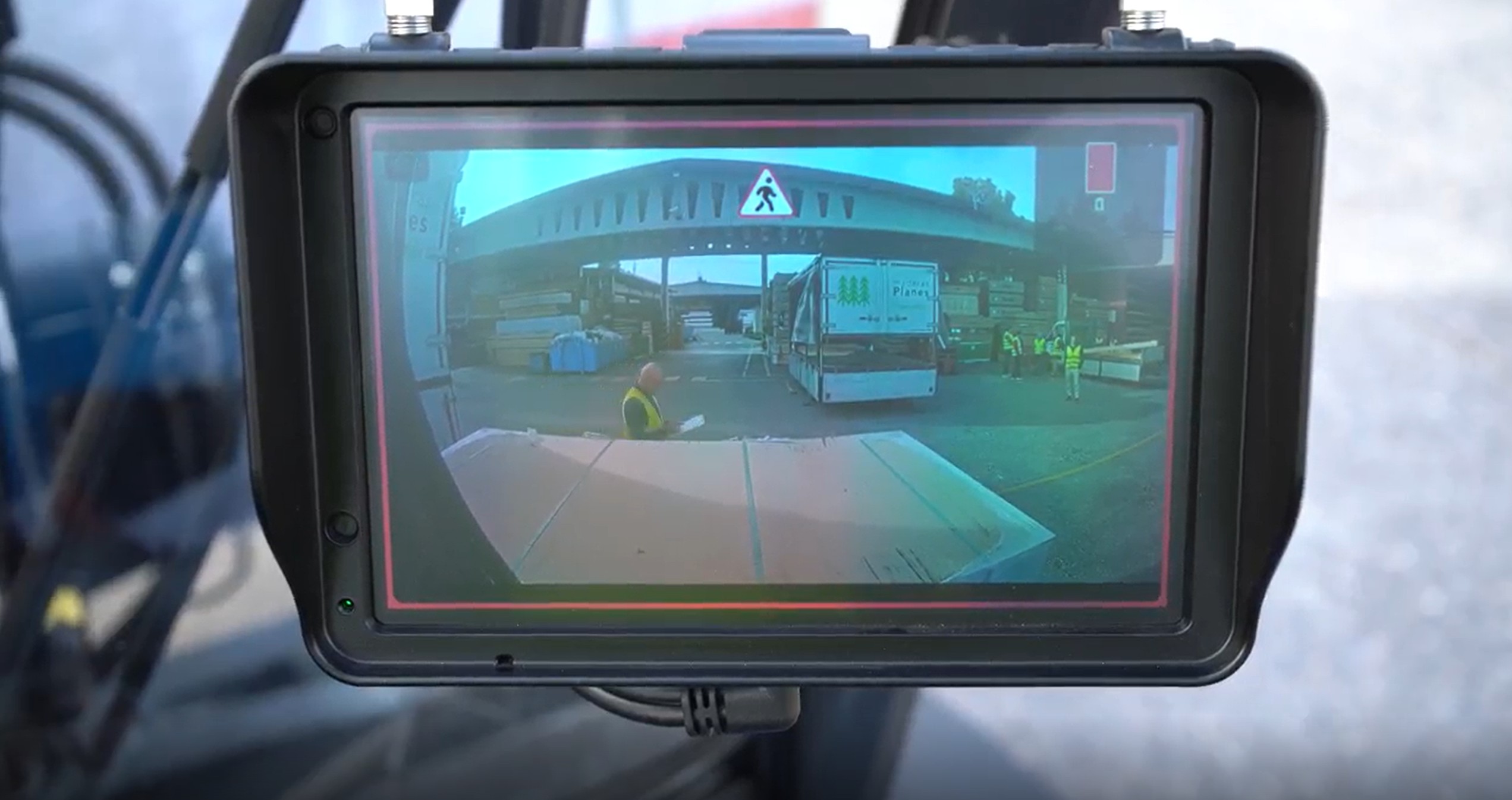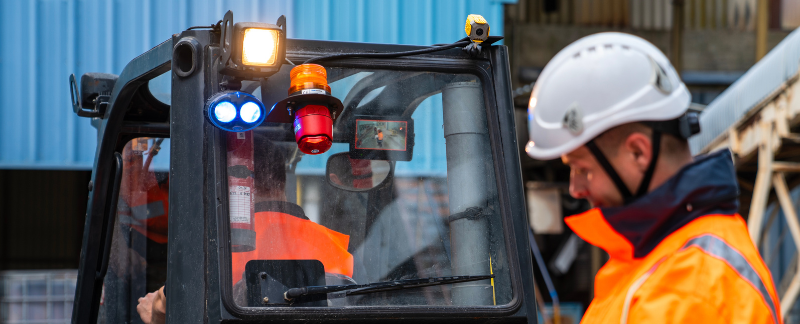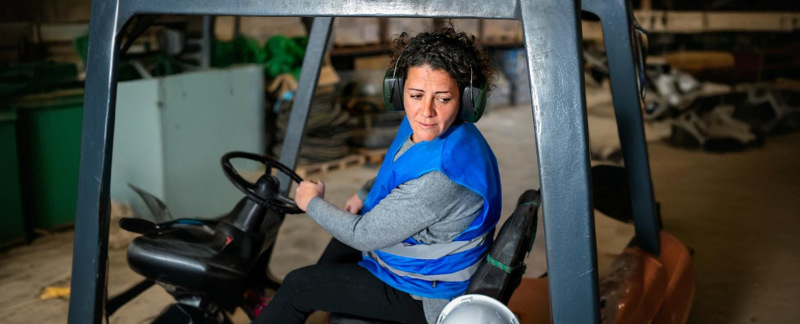Forklift Safety Cameras
Forklifts are vital in industrial settings, but they’re also a leading cause of workplace accidents. With safety under increasing scrutiny, many companies are turning to smart solutions like AI-powered forklift cameras. Technologies such as Blaxtair’s pedestrian detection system help prevent collisions by alerting operators in real time and improving overall situational awareness.
The Importance of Visibility in Forklift Safety
Forklifts operate in dynamic and often high-traffic industrial environments, such as warehouses, factories, and distribution centers. In these busy settings, the ability of an operator to clearly see their surroundings is crucial to maintaining a safe and efficient workplace. Unfortunately, forklifts inherently have significant blind spots, particularly behind the vehicle and around the mast area, where bulky loads can block the operator’s field of vision. This makes it difficult to see pedestrians, other vehicles, or obstacles.
According to OSHA and other safety authorities, limited visibility is a major contributor to forklift-related accidents, which can result in serious accidents, injuries, fatalities, and costly property damage. Incidents involving collisions with pedestrians, other vehicles, or structural elements like shelving and loading docks are not uncommon.
To address this risk, many companies are turning to forklift camera systems. These systems provide operators with real-time video feeds from strategically positioned cameras, giving them a clearer view of areas that would otherwise be hidden. With better visibility of their surroundings, operators can better detect and avoid hazards. Businesses can significantly reduce collision risks and enhance overall workplace safety.
How does a Forklift Camera Work
A forklift camera system typically consists of one or more high-definition cameras mounted on key parts of the vehicle, to provide a clear view of blind spots. Common mounting points include:
- The mast, to help the operator see the forks and ensure accurate load placement.
- The rear of the forklift, to provide a view when reversing.
- Overhead guard or side positions, to expand visibility in all directions.
The cameras capture real-time footage and transmit it to a display located inside the cabin, typically within the operator’s line of sight. This allows operators to continuously monitor their surroundings without turning their body or relying on less reliable rear-view mirrors and to make better-informed decisions.
More advanced forklift safety cameras go a step further by incorporating features like:
- Infrared night vision for low-light or dark environments.
- AI-powered object and pedestrian detection, which can identify and track people or obstacles and trigger automatic visual or audible alerts to improve safety in all working conditions.
- Wide-angle lenses to cover a broader field of view.
These features ensure consistent and maximum visibility across all working conditions and offer a level of situational awareness that traditional safety tools like mirrors cannot match.

Key Benefits of Forklift Cameras
Reducing Blind Spots and Preventing Accidents
Forklift blind spots are a major hazard, especially when transporting large or bulky loads that obstruct the operator’s line of sight. A well-positioned forklift safety camera virtually eliminates these blind spots, enabling operators to see around the entire vehicle, including behind and above. This significantly lowers the risk of collisions with pedestrians, racking systems, walls, vehicles and other equipment.
Enhancing Operator Awareness
Real-time video feeds from multiple camera angles allow operators to stay aware of their surroundings without constantly turning or repositioning themselves, reducing fatigue and strain.
Constantly checking mirrors or twisting the torso to look behind is physically demanding and can lead to operator fatigue and strain. Forklift cameras allow operators to maintain a comfortable, ergonomic posture while maintaining full situational awareness. Multiple camera angles displayed on a single screen enable the operator to observe all critical zones at once, boosting both confidence and concentration.
Improving Productivity and Efficiency
When operators can see clearly, they move more efficiently. Maneuvering in tight spaces, loading and unloading goods, and navigating complex layouts becomes faster and safer. Forklift camera systems also help enhance load placement accuracy, reducing the risk of dropping or damaging items and saving time otherwise spent correcting misalignments.
Fewer incidents and faster workflows mean less downtime, fewer damaged goods, and better overall productivity across the board.
Supporting Compliance with Safety Regulations
Organizations like OSHA in the United States and similar agencies worldwide require employers to minimize workplace hazards, including visibility issues. Forklift safety cameras help companies comply with these safety standards, reducing the risk of penalties and liabilities. They also support internal safety policies and can serve as valuable training tools for new or reassigned operators.
In the event of an incident, video footage from the cameras can also be used for investigation, providing a clear record of events and supporting a transparent safety culture.
Choosing the Right Forklift Camera System
Not all forklift camera systems are created equal. Choosing the right one involves evaluating the following factors:
- Camera Placement: Determine whether you need a camera positioned on the mast, at the rear, or a complete 360-degree solution. Consider how your forklifts are typically used and where visibility is most compromised.
- Video Quality & Night Vision: Opt for high-resolution cameras with infrared capabilities to ensure clear visibility in low-light or nighttime operations.
- AI-Powered Detection: Some advanced systems come with built-in AI that can recognize pedestrians. These smart cameras enhance safety by providing instant alerts to the driver when a risk is detected.
- Durability & Weather Resistance: Forklift environments can be harsh, with exposure to dust, moisture and extreme temperatures. Industrial-grade camera systems are designed to withstand these challenges without degrading in performance.
Before making a purchase, assess your operational needs, consult with your safety managers, and request demos from suppliers to evaluate real-world performance.

Integrating Forklift Cameras into Your Safety Strategy
AI-powered pedestrian detection solutions, like Blaxtair, can further enhance safety by automatically alerting drivers to potential hazards.
Forklift cameras are most effective when implemented as part of a broader workplace safety strategy. This includes:
- Proximity sensors to detect nearby objects or people.
- Audible and visual alarms to alert both the operator and those nearby.
- Training programs to ensure operators know how to use the camera system effectively.
- Regular maintenance and checks to keep the equipment functioning properly.
One of the most powerful combinations is integrating AI-powered pedestrian detection solutions, like Blaxtair, alongside forklift cameras. These systems automatically identify pedestrians and alert drivers in real time, dramatically reducing the chances of an accident.
Case studies show that businesses implementing forklift camera systems have experienced a significant reduction in accidents and property damage. By adopting these technologies, companies can create a safer and more efficient working environment. The initial investment pays off quickly through lower operational costs, reduced downtime, and better employee well-being.
The Future of Forklift Safety with Smart Camera Systems
As technology evolves, forklift safety is entering a new era of intelligent automation. The future of forklift cameras lies in:
- Real-time hazard detection and alerts
- Integration with automatic emergency braking systems
- Cloud-based analytics for performance tracking and incident reporting
- Connectivity with warehouse management systems (WMS) for synchronized logistics
AI-powered camera systems will not only alert operators to hazards but will also learn from behavior patterns to predict and prevent accidents before they happen. These smart systems will play a critical role in the evolution of Industry 4.0, where safety, automation, and efficiency go hand in hand.
Conclusions
Investing in a forklift camera system is a proactive step toward reducing accidents, improving efficiency, and ensuring compliance with safety regulations. By enhancing operator visibility and awareness, forklift cameras create a safer and more productive work environment.
For companies committed to protecting their workforce and optimizing material handling operations, the choice is clear: integrating advanced forklift camera technology is no longer a luxury, it’s a necessity.
Discover how Blaxtair’s AI-powered forklift safety cameras can help transform your safety strategy and optimize operations. Contact us today to learn more about our cutting-edge solutions designed to prevent accidents and protect your people.

